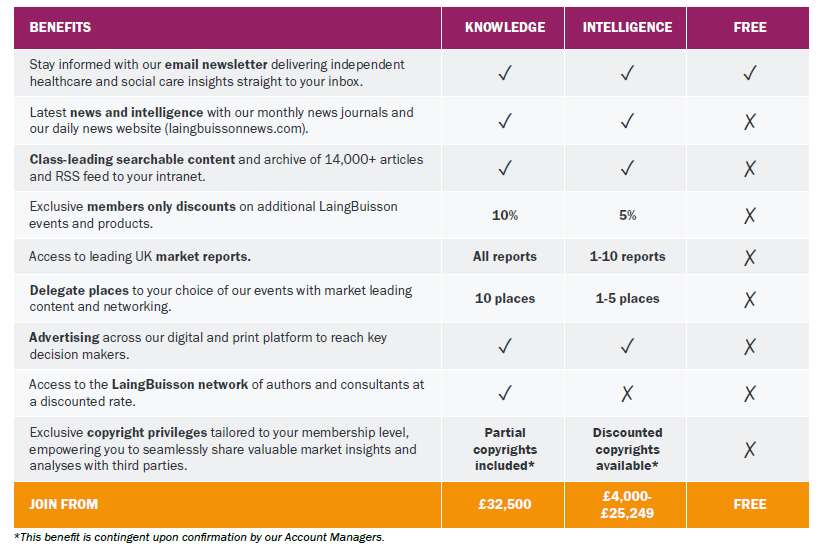Homecare and supported living – a curate’s egg of a market – good in parts, not in others
The UK addressable market for homecare and supported living is worth £9.1 billion (2016/17 figures), according to market intelligence company LaingBuisson, which has today published the second edition of its Homecare and Supported Living market report.
Almost all homecare and supported living is now provided by the independent sector, mainly for-profit companies, with local authority provision amounting to less than 5% of the addressable UK market. This is the exact inverse of the situation when the community care reforms of 1993 were introduced just two and a half decades ago.
This is not a single market, according to this fully revised and updated report, but rather a series of markets, each with its own strengths and weaknesses, market dynamics and profitability. Seven sub-markets are identified in total.
The largest, and most discredited, is the mainstream ‘time and task’ visiting homecare model. Many local authorities have exploited their monopsony purchasing power during austerity to shift risk to providers, cut visits to 30 or even 15 minutes and drive prices down relentlessly. In the process they have driven several providers to exit the market entirely, prompting some councils to ease the price pressure recently to sustain supply in the face of providers ‘handing back contracts’, but the real costs remain too high for councils. At the same time, there is also a parallel and much healthier ‘time and task’ model catering for private pay clients, where prices better reflect costs and the balance of power between customer and provider is more evenly balanced.
The report goes on to describe and analyse other business models, including supported living and homecare delivered to clustered settings, with the double bonus of better staff continuity as well as higher profitability through reduced overheads. Live-in homecare is another segment with its own dynamics and staffing model, which is rapidly expanding from a small base. The report also looks at the special characteristics of ‘complex care’, which is mainly NHS funded, and at largely privately funded franchised homecare business.
Strong growth in underlying demand is expected to continue for at least two decades and beyond, with homecare having the potential to grow at a CAGR (Compound Average Growth Rate) of 2.6% and supported living by a very similar 2.7%, according to LaingBuisson projections. The key driver of demand in homecare is the ageing population, while in supported living it is improved survival rates for younger adults with learning disabilities.
According to the report the full projected growth for homecare may not be realised, because of continuing government austerity measures. Three-quarters of homecare is publicly funded and, even if austerity were relaxed, the public funding envelope is unlikely to expand as rapidly as underlying demographic pressure. Expansion of supported living, in contrast, looks more assured, despite being almost 100% public funded. It has been given a ‘fair wind’ by from the Government’s policy decision in October 2017 to continue making enhanced rates of Housing Benefit available to underwrite the expansion of supported housing for younger adults with long term needs.
The main threat to providers of supported living services continues to be their back-pay liabilities arising from HMRC’s reinterpretation of workers’ right to be paid at National Living Wage for sleep-ins. The liabilities, which go back six years, could cause some providers to go out of business and during 2018 the sector will be eagerly awaiting news of what support, if any, government can offer.
William Laing, author of the report said:
‘Homecare and supported living remain among the most fragmented markets in social care. The ten largest providers combined have only a 16% share, which is the lowest in the independent health and social care sector. The absence of consolidation must be due, at least in part, to the harsh financial environment to which public facing homecare providers in particular have been exposed during the years of austerity since 2010/11, with operating profits falling close to zero, and even into negative territory for some providers. Even when austerity relaxes, it may be difficult to re-establish their strategic commitment to the mainstream public facing sector.
‘But not all is bad news. There are many segments of the homecare and supported living sector which remain profitable and where business models remain sustainable. There are also several success stories, of companies able to grow both organically and by acquisition despite an often challenging market environment.’
The report ends by looking at market potential, focusing on the potentially transformative effect of health and social care integration, which is currently one of the government’s flagship policies. Bringing together health and social care offers the potential to transform the market for publicly paid homecare and supported living by moving away from the current, flawed ‘time and task’ model to one based on outcomes. There are obvious opportunities, the report points out, in integrating council funded homecare and NHS funded district nursing services, where visiting staff often do the same jobs and sometimes even meet each other on their clients’ doorsteps.
More speculatively, the report argues, there could be real potential from turning the public sector’s policy of rationing by eligibility criteria on its head. Two innovative models of social care are described which promise ‘more for less’ by harnessing community resources to offer early intervention. Their common premise is that early intervention may also minimise the need for high intensity social care which absorbs most local authority budgets at present.
William Laing concluded:
‘We must also not forget the opportunities created by digitally-enabled homecare. While this market is still in its infancy and may not create much change in the short term, it could ultimately be transformative in the way care in the home is delivered.’







